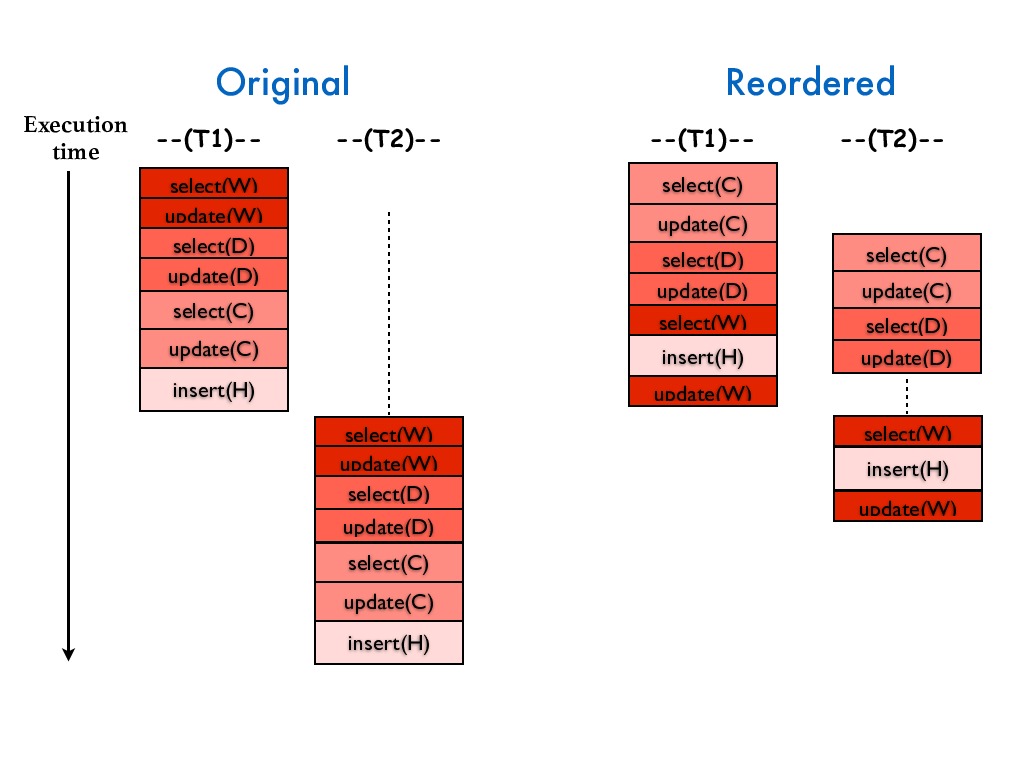Quro
This is the project webpage for Quro, a query-aware compiler that automatically reorders
queries in database transactions to improve application performance.
On this page we provide instructions to run the experiments included in our VLDB 16
paper, along with link to the Quro source code.
Contact the Quro developers if you have any comments about Quro.
Sign up on the Quro users mailing list
to receive updates.
This project has been generously supported by NSF.
Logging on to the Quro virtual machine
- Make sure virtualbox is installed.
- Import and start the VM:
VBoxManage import quro_lite.ovaVBoxManage startvm quro_lite --type headless (username: quro, password: qurotest)- Login to the VM via VirtualBox GUI, or:
ssh -p 2345 quro@localhost
What’s in the VM?
- The benchmarks (both original and QURO-generated implementations) evaluated in the paper. (source code on github)
- QURO built with clang libtool. (source code on github)
- A database (forked from DBx1000) and TPC-C benchmark to evaluate the performance of different concurrency control schemes. (source code on github)
- MySQL 5.5 database server. To check out the configurations for the server:
quro@ubuntu:~$ vi ~/.my.cnf
Following are brief instructions to run each code with basic settings. For more detailed instructions, go to detailed instructions or checkout the "QURO_readme" file under each code repository.
Reproducing the evaluation:
- Start MySQL server:
quro@ubuntu:~$ cd ~/mysql-5.5/mysql-5.5.45-linux2.6-x86_64/support-files
quro@ubuntu:mysql-5.5/mysql-5.5.45-linux2.6-x86_64/support-files$ ./mysql.server restart
quro@ubuntu:~$ cd ~/dbt5
- Configure the benchmark:
- Open a configuration file, for example:
quro@ubuntu:dbt5$ vi src/scripts/configuration.example
- Specify the configurations, including benchmark name, type of transaction, running time, number of clients, etc.
- Compile and run:
- The script run_by_config.py will read the configuration file, then compile and run the workload.
quro@ubuntu:dbt5$ python run_by_config.py configuration.example
Results will be saved in ~/results/{BENCHMARK}_{CONFIGURATIONS}/. CONFIGURATIONS include transaction name, implementation type (original/reordered), number of server threads, total running time, etc. Under the directory, the performance related data (number of commits/aborts, total running time for each thread, etc) can be found in ${BENCHMARK}/${BENCHMARK}.out.
For a single run with a certain number of clients, the application will be running for 5 min, and then sleep for 2 min to wait for file writing and data collecting. The total running time depends on the number of runs. For example, if you specify "CONNECTIONS" in the configuration file to be the sequence "2 4 8 16", the script will run the workload for 4 runs, on 2, 4, 8, 16 clients. So altogether it takes 28 min to finish.
The database for TPC-C, TPC-E and BID has already been created on the VM. Checkout detailed instructions for more instructions on populating your own database, and other instructions including running stored-procedure implementation.
What to expect: The lite VM is expected to run on 16 processors and 32GB memory. The lack of computational resources will largely affect the results. Since the database and the clients are running on the same machine, it would be better to run experiments with no more than 8 clients (8 database connections). For TPC-C benchmark, when running 4 clients on payment transaction, reordering should have ~2x throughput comparing to the original implementation.
Using QURO to reorder queries:
quro@ubuntu:~$ cd ~/llvm/test/
quro@ubuntu:test$ ./quro_reorder.sh ${TRANSACTION FILE NAME}
A number of predefined file names include payment, neworder, bid. Choosing each of these will
run Quro on simple_{TRANSACTION}.cpp by making use of the query contention indexes
stored in {TRANSACTION}_freq.txt.
The reordered transaction code will be in output.cpp under the same directory where you run the quro_reorder script.
- Connecting to external ILP solvers is still under construction. The version of Quro on the provided VM uses a simple heuristic to reorder all statements instead of using an ILP solver, but it can generate input for ILP solver and let it compute the final order of queries/units. To use the external ILP solver,
checkout ~/ILPsolvers/code/lp_solve_5.5/quro/QURO_readme for instructions to run lpsolver, or
checkout ~/ILPsolvers/code/gurobi/QURO_readme for instructions to run gurobi.
Comparing to other concurrency control schemes:
quro@ubuntu:~$ cd ~/DBx1000/
- Configure the database:
quro@ubuntu:DBx1000$ vi config.h
To specify concurrency control schemes, change #define CC_ALG {ALGORITHM}, where ALGORITHM is either one of
NO_WAIT, DL_DETECT, MVCC, OCC.
NO_WAIT and DL_DETECT are two implementations of 2PL. NO_WAIT aborts the transaction when it touches a locked tuple, and DL_DETECT monitors wait-for graph and aborts one transaction upon finding a cycle. For more details, check out Xiangyao's paper Staring into the Abyss: An Evaluation of
Concurrency Control with One Thousand Cores.
To specify the total number of transactions to run for each thread, change #define MAX_TXN_PER_PART
To specify the number of database client, update #define THREAD_CNT
- To execute the original implementation under 2PL, copy the transaction file to the
benchmarksdirectory:
quro@ubuntu:DBx1000$ cp temp_transaction_file/tpcc_txn.cpp benchmarks/tpcc_txn.cpp
- To execute the reordered implementation under 2PL, copy the transaction file to the
benchmarksdirectory:
quro@ubuntu:DBx1000$ cp temp_transaction_file/reorder_tpcc_txn.cpp benchmarks/tpcc_txn.cpp
- Compile:
quro@ubuntu:DBx1000$ make
- Run:
quro@ubuntu:DBx1000$ ./rundb
The program will start the database, populate it and then run the transactions under specified concurrency control scheme.
What to expect: Each thread will run the number of transactions as specified in config.h.
When all threads finish, the following will be printed on the screen:
txn_cnt: total number of commited transactionsrun_time: total running time and throughput (txn_cnt/run_time)
The default configuration runs on 8 threads and 1000 transactions for each thread.
The program is expected to finish within seconds. Under the default setting,
the throughtput of the reordered implementation under DL_DETECT is ~2x than original,
and ~1.35x for NO_WAIT.
The throughput of the reordered implementation under DL_DETECT is ~2.5x
compared to OCC, and ~1.1x compared to MVCC.
